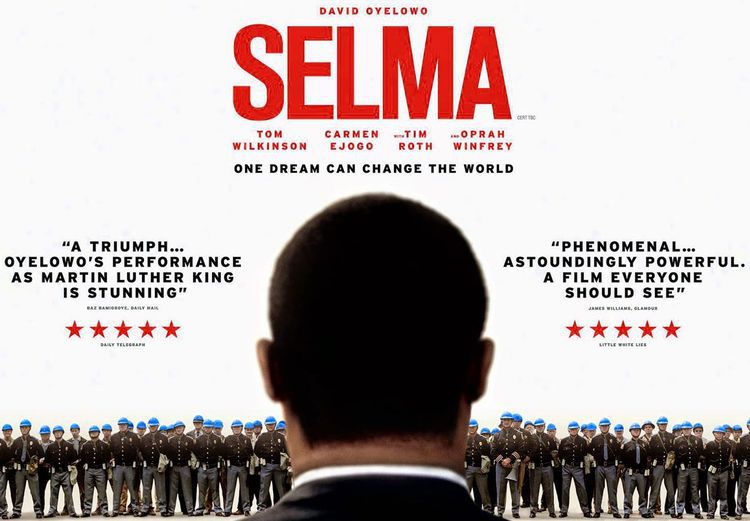
Selma to Ferguson, Ferguson to Selma: What Happened After the Reporters Left
01/12/2015
The real story of Selma, Alabama isn’t what Hollywood put on the screen. It’s about what happened after the protesters got what they wanted and the reporters left.
Selma is back in the news because of the eponymous film, very loosely based on Martin Luther King’s 1965 voting rights marches, the latest installment in the burgeoning cinematic genre of “hate porn.” It just bombed at the Golden Globes, prompting the usual charges of racism. [‘Selma didn’t win much at the Golden Globes. Are politics to blame? By Nia-Malika Henderson, Washington Post, January 12, 2015]. As Rachel Maddow impersonator Christopher Hayes put it,
Real white-out happening.
— Christopher Hayes (@chrislhayes) January 12, 2015
But Hollywood has a bigger problem if it wants to continue its reliance on anti-white agitprop. Curiously, while most Hollywood blockbusters rely on the foreign market to bring in the bulk of the gross receipts, hate porn is almost entirely dependent on the American market. To look at some examples:
- 2011’s The Help made 78 percent of its lifetime gross ($216 million) in the domestic market.
- 2012’s Red Tails was a box office bomb, grossing only $50 million worldwide, with an astonishing 99 percent of the share coming from the domestic market. A paltry $489,000 was grossed in the worldwide market
- 2013’s The Butler made 66 percent of its lifetimes gross ($176 million) in the domestic market.
One exception: 2013’s 12 Years a Slave, which despite massive marketing and industry backing made only 30 percent of its worldwide gross ($187 million) from the American market. This may indicate a law of diminishing returns in the American market, as audiences weary of what is essentially the same movie over and over again.
Still, the film industry seems determined to double down on hate porn. Selma was produced by Brad Pitt and Oprah Winfrey for an estimated $20 million [Oprah Winfrey Joins Brad Pitt as Producer of MLK Drama ‘Selma,’ by Lucas Shaw, The Wrap, January 19, 2014]. It was directed by black female director Ava DuVernay, a diversity twofer duly celebrated by the Main Stream Media [Making History, by Manohla Dargis, New York Times, December 3, 2014]. But Selma only opened to just over $11 million, managing to lose to Liam Neeson once again losing his family in Taken 3. [‘Selma’ Movie Opening Weekend Bested by ‘Taken 3’ Despite Critical Acclaim, by Aaron Morrison, International Business Times, January 12, 2015]
Of course, it’s not really about making money. It’s about imposing a permanent sense of white guilt of the historic American nation. And those older whites who may be tainted by “prejudice and racism” “just have to die,” to use Oprah’s notorious words. [Oprah: Racists Have to Die for Racism to End, by Noel Sheppard, Newsbusters, November 15, 2013] The object: to train young whites to willfully ignore racial reality and not “read, say, or think” anything PC, to use John Derbyshire’s phrase.
But both American blacks and whites will eventually have to face the consequences of what happened in Selma after the reporters left. Just as Birmingham, Alabama became a failed city after the achieving of black political power, so is present day Selma a reminder that Hollywood’s history seldom resembles the real thing.
Selma in 1965 was roughly half-white and half-black. But in the years since King’s march, the white population has declined by roughly 10,000 people and the city lost 30 percent of its total population [As ‘Selma’ wow Hollywood critics, white flight and poverty haunt Selma, by Jeremy Gray, AL.com, January 7, 2015] Today, the 80% black city is a ruin.
According to Public School Review, Selma High School and its 982 students is almost entirely black. Some 80 percent of students get a free lunch.
As recent as twenty years ago, there was still a small white population. However, Southern Changes magazine complained,
The student body has been majority African American since 1975, four years after integration. Currently, more than eighty percent of the students are black. Until very recently, the school had never been governed by a school board with a black majority. In all of the years since integration, there has been one black valedictorian and one black salutatorian.[Selma: What Has Changed?, Southern Changes Volume 12, Number 4, 1991]
They and other “diversity campaigners” got what they wanted. In 2000, majority-black Selma finally elected its first black mayor, James Perkins Jr. This event was heralded as the “biggest news to hit Selma since slavery fell”:
"His victory gives many people a sign of hope, not just in Selma, but in Alabama and the rest of the world," says the Rev. Frederick Douglas "F.D."Reese, Perkins’s pastor at Ebenezer Baptist Church. "Selma, as I see it, has been chosen to be … a beacon of a brighter tomorrow."
[Selma steps away from its troubled past, by Robin Demonia, Christian Science Monitor, October 2, 200]
But how did that play out? Under the “brighter tomorrow” of Third World leadership, Selma couldn’t even maintain a movie theater. The “Walton Theater,” once a famous landmark that hosted “talking pictures” as far back as 1932 and amateur talent shows, was eventually closed because there were no private investors to back the project, even after heavy investment by the city government.
Saturday marked the end of an era at the Walton Theater.After two years of operation, the Jackson family showed its last movie Saturday — “A Madea Christmas.”
Sharon and David Jackson decided to end management of the city-owned facility after the Selma City Council’s Public Building’s Committee decided not to approve a transition proposal or present a counter offer…
The Walton Theater originally opened in 1914… In the 1970s, the theater fell into a state of disrepair and was closed.
Selmians helped to raise more than $1 million to reopen the theater. It reopened in May 1985 after five years of planning and construction, spearheaded by local residents Larry Striplin and Anita Bryant.
The theater stopped showing feature films in the 1990s.
In October 2011 David and Sharon Jackson partnered with the City of Selma to reopen the Walton as a first-run movie theater. The city helped by purchasing new state-of-the-art digital and sound systems. The first film shown in the Jackson’s Walton Theater was “Mission Impossible IV,” according to the theater’s website.
[Movies come to a close at Selma’s Walton Theater, by Josh Bergeron, Selma Times Journal, December 21, 2013]
Naturally, this led to an awkward situation when it came time to screen Selma in the town that inspired the movie. The Walton Theater was reopened just for the movie. Once the show is over, a ruined city where more than 40 percent of the people live in poverty will remain. [Fear and joy as Alabama town readies for screenings of film ‘Selma,’ by Jonathan Kaminsky, Reuters, January 3, 2015]
And this serves as a metaphor for whole sad story of Selma. Oprah Winfrey and Hollywood will continue to roll out Civil Rights pornography, Al Sharpton and Jesse Jackson will continue their extortion rackets, and the great passion plays of the Civil Rights Movement will be re-enacted again and again. Whites will be called racist for leaving black run cities, and if they don’t flee, they will be called racist for staying.
The Civil Rights Movement got exactly what it wanted. Its leading figures, like Martin Luther King Jr., have been enshrined as American saints. Black power reigns in what were some of the leading cities of the Old Confederacy.
But formerly First World cities like Selma, Birmingham, and Detroit will still be Third World slums, no matter how many Hollywood movies are made about the evils of Whites. And no amount of white guilt will comfort those who have to live in the ruins.
Like Shelley’s Ozymandias, of the colossus that was the American Civil Rights Movement, nothing beside remains.

